Effective Lighting Strategies for Herb Growth
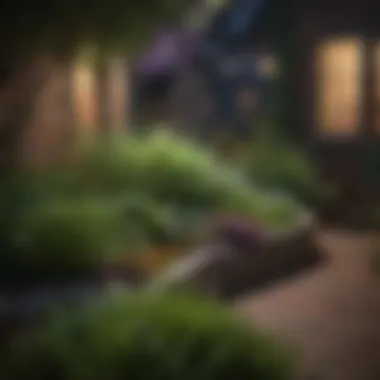
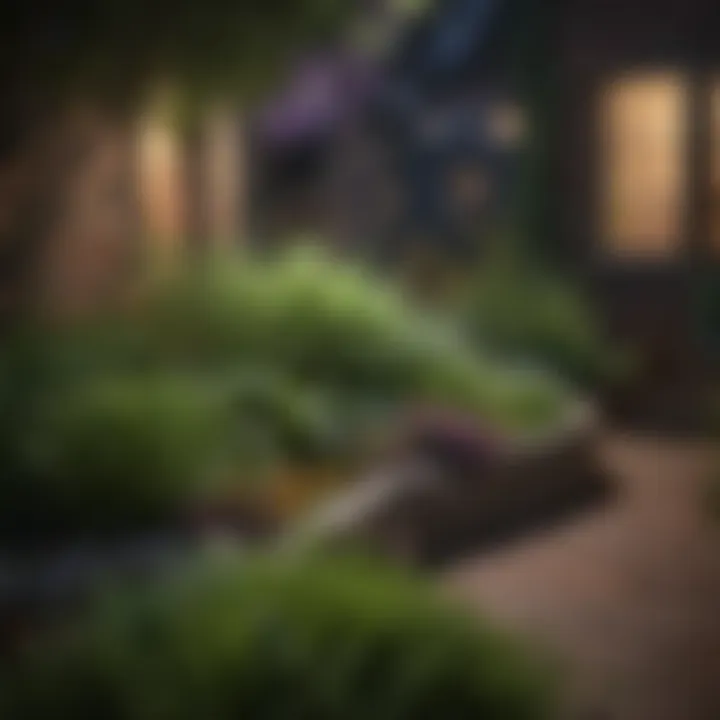
Intro
Cultivating herbs isn’t just about good soil and water; light is the unsung hero in the growth saga of these aromatic plants. In the quest for the ideal herb garden, understanding the role of light can take your plants from mediocre to magnificent. With myriad options available, the decision on how to light your indoor or outdoor cultivation space can be overwhelming. This article aims to lift the veil on the significance of light in herb gardening. We’ll contour through various lighting solutions, their unique properties, and how they can impact your garden’s productivity.
Grasping the dynamics of light can revamp your growing game. Each herb species has its own light cravings. Some thrive in bright direct sunlight, while others flourish under softer, indirect rays. Optimizing these lighting conditions can result in lush foliage, vibrant blooms, and an abundance of flavorful herbs ready for your kitchen or herbal remedies.
By the end of this exploration, you’ll be armed with insights to make choices that suit both inexperienced growers and seasoned botanists alike. Dive in, and let's shed some light on the optimal solutions for herb cultivation.
Foreword to Herb Lighting
Lighting plays a pivotal role in the life of plants, especially herbs, which are often touted for their delicate flavors and fragrances. Understanding the various facets of herb lighting is not just an academic pursuit; it's the cornerstone of a successful herb garden. Proper illumination can make all the difference between herbs that thrive and those that merely survive. The relationship between light and plant health is intricate, with several layers to explore.
The importance of the content in this section lies in the way it sets the foundation for the subsequent discussions on specific types of lighting, light spectrums, and effective placement techniques. For novice growers, comprehending these basic principles will feel like discovering a treasure map; for seasoned horticulturists, it’s a chance to refine their craft with strategies that promise richer yields.
Understanding Plant Light Requirements
Each plant has its own light requirements. If herbs were musicians, different species would play an entirely different tune when it comes to photosynthesis. Some herbs, like basil and cilantro, thrive in direct sunlight, while others might prefer a more shaded environment. The spectrum of light—from ultraviolet to infrared—has various influences on germination, growth, flowering, and overall health.
- Light Intensity: Different herbs require various levels of light intensity. For example, rosemary enjoys strong light, while mint can adapt to lower levels.
- Duration of Light Exposure: Most herbs require around 12 to 16 hours of light per day. Understanding how long to keep lights on is crucial.
- Light Quality: This refers to the color of the light. Plants primarily use red and blue wavelengths for photosynthesis.
By paying attention to these factors, gardeners can create optimal conditions tailored for individual herbs, which can result in healthier plants and more vibrant flavors.
Importance of Proper Light for Herbs
Without adequate light, herbs fail to flourish. Proper lighting formats the bedrock upon which robust herb gardens are established. The roots of this importance are planted deeply in several core aspects:
- Photosynthesis: Proper light powers the photosynthesis process, which transforms sunlight into energy. This is how plants grow, develop, and produce essential oils that give herbs their unique characteristics.
- Health and Wellness of the Plant: Insufficient lighting can lead to weak, leggy plants that are susceptible to pests and diseases. On the flip side, excessive light can scorch tender leaves.
- Flavor Development: The intensity and duration of light directly affect flavor profiles. Herbs grown under the right lighting conditions often have stronger and more vibrant flavors.
"Light is not just a physical phenomenon; it's a source of life for plants and a key to flavor and health."
The journey to a successful herb garden starts with understanding and respecting these light-related aspects. The next sections will explore the wide assortment of lighting options available, diving deeper into how each one interacts with these fundamental plant needs.
Types of Lighting for Herb Growth
Lighting serves as the lifeblood of herb growth, influencing everything from germination to flowering. It's not just about throwing a bulb in a dark corner and hoping for the best; rather, the kind of light and its particular characteristics can make or break your herb garden. This section delves into varied lighting types, assessing their unique benefits and drawbacks, so one can choose wisely based on their specific gardening needs.
Natural Sunlight
Nothing quite matches the rhythm of the sun when it comes to growing herbs. Since time immemorial, sunlight has been the go-to source for plant nourishment, powering photosynthesis and fostering robust growth. The benefit of natural sunlight is its full spectrum, providing the right wavelengths that help promote lush foliage and vibrant blooms without the high cost of electricity.
However, using natural light does come with its setbacks. Not everyone has a garden bathed in sunlight for hours on end.
- Consider the following:
- Seasons affect sunlight hours and intensity.
- Weather can be unpredictable, fluctuating daily between cloudy and clear.
- Indoor growers often face the struggles of light-deprived environments.
For those lucky enough to have direct sun, it can be the cheapest and most effective way to go about herb cultivation.
Incandescent Lighting
Incandescent bulbs might bring to mind cozy evenings and glowing lamps, but they don't rank high in the herb-growing world. While they emit a warm light, their spectrum is off-kilter, lacking the essential wavelengths needed for healthy plant growth. They're often more suited for ambiance rather than cultivation.
- Potential downsides:
- High heat output that can dry out your soil.
- Limited efficiency; they convert only a tiny fraction of energy into usable light for plants.
- Cost implications pile up due to the need for frequent replacements.
That said, if a grower has no other options and is simply looking to keep a few herbs alive indoors, incandescent light can suffice—but it isn't optimal.
Fluorescent Lighting
On the flip side, fluorescent bulbs come in a variety of sizes, offering growers flexible options without the heat of incandescent lights. They provide a decent spectrum of light and use significantly less energy, making them a popular choice for many hobbyists.
There are two main types:
- T5 fluorescents: Slim and efficient, ideal for tight spaces.
- Compact fluorescents (CFL): User-friendly; can fit in standard outlets.
Yet, they do have a lifespan and may not be as robust as other lighting methods when it comes to larger operations. Overall, they struck a happy balance between cost and efficiency, especially for those starting with herb gardening.
LED Lighting
LEDs have made quite the splash in the gardening community, and for a good reason. These lights are synonymous with efficiency, offering a spectrum tailored specifically for plant growth. They run cool, minimizing the danger of burning your plants, while using pennies on the dollar regarding energy consumption.
"The right LED setup can transform your indoor garden into a thriving oasis."
Additionally, LEDs last significantly longer than other lighting types and take up much less space. The initial cost might be higher, but their longevity and lower operational cost essentially pay for themselves over time.
- Benefits of LEDs include:
- Customizable light spectrum.
- Minimal heat production.
- Longevity and low energy consumption.
High-Intensity Discharge (HID) Lighting
If you're looking for power, HID lighting is the way to go. These lights produce an intense output, ideal for larger garden setups. They come in two types: Metal Halide (MH) and High Pressure Sodium (HPS), each catering to different growth stages but both highly efficient.
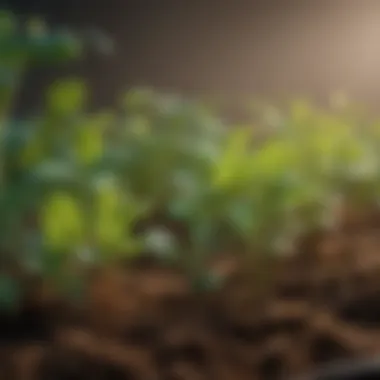

Consider using MH during vegetative stages with its blue spectrum and HPS for blooming with a redder spectrum.
However, they’re not without their downsides:
- HIDs generate significant heat, necessitating effective ventilation strategies.
- They do require a ballast, which is an additional cost of setup.
- Wattage ranges can significantly affect electricity costs over time.
Evaluating Light Spectrums
Light is the lifeblood of plants, especially for those delicate herbs that many gardeners cherish. When it comes to herb cultivation, understanding light spectrums is essential. Different wavelengths of light can trigger various physiological responses in plants, influencing everything from growth rates to flavor profiles. Getting this aspect right means healthier, more vibrant herbs that produce at their best.
To grasp the significance of evaluating light spectrums, one must acknowledge the two main types of wavelength ranges that matter most: red and blue light. These colors aren’t just pretty – they play pivotal roles in photosynthesis. It’s a bit like cooking; if you don’t have the right ingredients, the dish just won’t turn out the same.
Red and Blue Light For Photosynthesis
Plants primarily rely on red and blue light to fuel their growth. Red light, typically ranging from around 620 to 750 nanometers, is crucial during the flowering and fruiting stages of herb growth. For instance, if you’re growing aromatic basils or fragrant mints, ensuring they receive ample red light can lead to a more robust yield. On the flipside, blue light, occurring in the 450 to 495 nanometer range, supports vegetative growth and leaf development. Think of it as the greenhorn aspect of plant growth; blue light encourages sturdy stems and lush foliage.
When assessing the light in your growing environment, consider these aspects:
- Intensity matters: Too little blue light can result in leggy plants, while an overabundance of red could lead to weak stem structures.
- Color ratio affects growth: A balanced mix of these lights is key; it’s often recommended to aim for a ratio of about 2:1 of red to blue light for optimal results.
"Plants perceive red and blue light differently, and using a harmony of both can truly result in lush, flavorful herbs that elevate any garden."
Full Spectrum Lighting Explained
Full spectrum lighting refers to lights that emit all colors across the light spectrum, mimicking natural sunlight. For those looking to cultivate a robust herb garden indoors or under artificial setups, full spectrum lights serve as the jack-of-all-trades. They allow for photosynthesis across the entire plant lifecycle.
Full spectrum lighting isn’t just about achieving a rainbow look in your grow room. The benefits of using such lights include:
- Versatility: They can support everything from seedling development to flowering, eliminating the need for multiple light systems.
- Enhanced growth rates: Studies indicate that full spectrum light can help shorten growth cycles, resulting in faster harvests.
- Improved plant health: These lights can contribute to stronger stems and thicker leaves, yielding herbs that are not only hardy but also flavorful and aromatic.
Incorporating full spectrum lighting into your herb cultivation strategy can offer significant advantages, empowering both novice and experienced gardeners alike to achieve thriving indoor gardens all year round.
Key Considerations When Choosing Lighting
When it comes to cultivating herbs, the type of lighting you select can make or break your garden. It’s not just a matter of slapping any old bulb in and hoping for the best. There are three fundamental aspects to think about: the size of your growing space, the specific herbs you’re tending, and of course, your budget. Let’s unpack these elements.
Size of Growing Space
The dimensions of your growing area significantly influence the light choice you should make. A small window sill might suffice for a few pots of basil, but larger spaces like greenhouses or indoor gardens require more robust lighting solutions. You want to ensure that every plant gets its share of light without creating hotspots or underlit zones.
- Tips for managing light in different sizes of spaces:
- If you’re planting in a compact area, consider using adjustable LED grow lights that you can position nearer to the plants. This helps maximize light efficiency.
- For expansive setups, multiple light sources may be necessary, spaced evenly to ensure uniform distribution.
By taking into account your area’s size, you can avoid any pitfalls like wasted energy or insufficient light.
Type of Herbs Being Grown
Next up is what you’re growing. Not all herbs are created equal when it comes to their light needs. Some are low-light lovers, thriving in less direct sunlight, while others crave more intensity. Take mint, for instance; it can grow well in partial sun. Conversely, if you’re aiming to cultivate something like rosemary, it’ll stretch towards bright light—and lot's of it.
Here’s a rundown of how different herbs fare with light:
- Low Light Tolerant Herbs:
- Medium Light Requirement Herbs:
- High Light Demand Herbs:
- Mint
- Parsley
- Basil
- Thyme
- Oregano
- Chives
By understanding the light preferences of your chosen herbs, you can tailor your lighting setup, ensuring those delicate leaves receive just the right amount of brilliance.
Budget Constraints
Ah, the ever-present budget. Nobody has a bottomless wallet. When discussing lighting for your herb garden, it’s essential to grasp the long-term implications of your choices. You might find yourself tempted by the allure of high-end options like HID lights, which can provide fantastic results, but they also soar in operational costs.
- Consider these budget-friendly possibilities:
- Fluorescent lights are generally cost-effective to purchase and operate. They do a great job for herbs needing moderate light.
- LED grow lights might have a higher upfront cost, but their energy efficiency pays off in the long haul.
Evaluating the balance between initial investment and ongoing costs leads to smarter decisions. Remember, spending a bit more upfront can sometimes save a bundle later.
"By understanding the specific needs of your growing environment, you can streamline your lighting choices and get the best out of your herbs."
Ultimately, making informed choices on these fronts can help you craft an environment where your herbs not only survive but truly thrive.
Measuring Light Intensity
Measuring light intensity is crucial for optimal herb cultivation. Using the right amount of light can make the difference between a thriving herb garden and one that barely makes it. Without adequate intensity, plants may stretch towards the light, becoming leggy, or worse, not produce any new growth at all. Understanding how to measure light accurately can aid in avoiding these pitfalls, ensuring that herbs receive just the right amount of light required for healthy development.
Light intensity plays a role in photosynthesis, which is how plants convert light energy into chemical energy. Not all light is created equal, and measuring it can help gardeners fine-tune their lighting setup to achieve best results.
Key benefits of measuring light intensity include:
- Optimizing Growth: Knowing your lights’ intensity helps you adjust the distance or duration of exposure, promoting healthy growth.
- Preventing Stress: Too much light can lead to light stress, while too little can stunt growth; accurate measurement can help maintain a balance.
- Time Efficiency: By assessing real light conditions, you can save time on guesswork and focus on what benefits the plants the most.
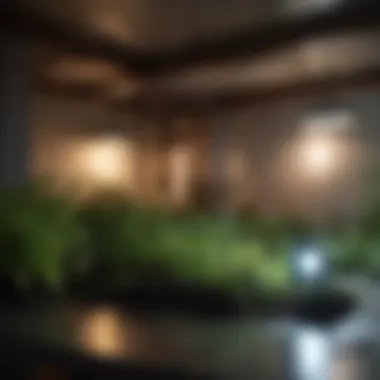

By implementing appropriate measurements from the start, herb growers can avoid headaches down the line.
Understanding Lux and PAR
When discussing light measurement, two major terms to know are Lux and Photosynthetically Active Radiation (PAR).
- Lux quantifies the illuminance level of light received on a surface. It's useful for general assessments but doesn’t necessarily reflect how plants utilize light.
- PAR, on the other hand, is the portion of the light spectrum (400-700 nanometers) that plants use for photosynthesis. For herb growth, focusing on PAR provides a more meaningful understanding of potential growth conditions.
Thus, while lux is still used, PAR is the star of the show when it comes to optimizing growth. A gardener should prioritize measuring PAR over Lux to accurately gauge how well their herbs will respond to specific lighting setups.
Using Light Meters for Assessment
For effective light assessment, the right tools are essential. Light meters can be an investment but are invaluable for serious herb cultivators.
Here are some types of meters to consider:
- Lux Meters: Great for basic light readings, especially if you're trying to understand overall light levels in the environment. However, just knowing lux isn’t enough for herb cultivation.
- PAR Meters: These specifically measure light intensity in the ranges beneficial for plant growth. They offer a direct insight into whether your herbs are receiving enough usable light.
"Investing in a good quality PAR meter can save time and improve harvests, allowing cultivators to make informed decisions about their lighting setups."
Light meters are fairly easy to use. Just place the sensor at the plant level where the herbs receive direct light, take the reading, and compare it to recommended ranges for the types of herbs you are growing. Key considerations include:
- Timing of readings: Measure light intensity at different times of day to get a complete picture.
- Variability: Remember to assess the ambient light conditions and not just those from artificial sources.
Heating and Light
In the intricate dance of herb cultivation, light plays a leading role, but it doesn’t do so alone. Heat, that invisible partner, has a crucial part to play. Understanding how heating interacts with lighting can make all the difference in achieving healthy, vibrant plants. When selecting lighting solutions, one must consider not only the light spectrum but also how the emitted heat can affect growth conditions. For instance, some lights, like incandescent bulbs, bring with them a considerable amount of heat, which can inadvertently raise the temperature of the growing space.
A balance between heat and light can enhance growth rates and vitality, but too much heat can lead to stress and damage. Getting this right is essential for optimal herb cultivation and may require some finesse in managing your indoor gardening environment.
Impact of Heat Emission from Lights
Light sources don’t just brighten a room; they bring heat along for the ride. This heat emission can alter a plant's health and development. For example, LED lights are known for being cooler, meaning they emit less heat compared to high-pressure sodium or metal halide lights. If you’re using a fixture that generates a lot of heat, you might need to do some serious adjusting—in terms of distance from plants, for instance, which can increase or decrease heat exposure.
- Too Much Heat: Plants may start to exhibit signs of stress, such as crispy leaves or dropped blooms.
- Too Little Heat: On the flip side, insufficient warmth can slow growth and hinder vital processes.
Thus, it’s good practice to monitor not just light but temperature as well. Utilizing infrared thermometers can help gauge how warm things really are underneath that light fixture, ensuring that you’re neither cooking nor freezing your herbs.
Cooling Solutions for Indoor Gardens
Now, if the heat is cranked up too high, you need a game plan. Cooling solutions become the knight in shining armor for your indoor garden, maintaining a friendly environment for your herbs. Here’s a handful of strategies that could help keep things cool:
- Ventilation Fans: These can create air movement, alleviating heat by circulating cooler air throughout your growing area.
- Reflective Surfaces: Mirrors or mylar can bounce light around without raising heat levels, giving you brighter conditions without the danger of overheating.
- Choosing the Right Light Fixtures: opting for cooler lighting options like LEDs not only saves on energy but also helps keep temps down.
In a nutshell, balancing light and heat is key. It’s a bit of trial and error, but once you pinpoint the right conditions, your herbs might just flourish in ways you never thought possible.
"The art of cultivation lies not just in nurturing light but also in regulating the warmth for optimal growth."
Arming yourself with knowledge about heating and cooling can only boost your success in herb cultivation. After all, it’s not just a game of light; it’s about creating a perfect environment where your herbs can thrive.
Effective Light Placement
Proper lighting placement is a cornerstone of successful herb cultivation. It's like having the right foundation for a house; without it, everything else falls apart. Getting the light positioning spot on not only maximizes energy use but also promotes healthy growth in herbs. Herbs are living organisms that sense their surroundings, and they react significantly to light variations. This section is about the art and science of placing lights effectively to ensure that your herbs thrive.
Distance from Plants
Finding the right distance between the light source and plants is critical. Too close, and you risk burning those tender leaves; too far away, they might stretch out like they’re straining for a breath, leading to weak growth. Here are a few considerations to keep in mind:
- Intensity Matters: Different light types emit various intensities. For example, LED lights are often more intense but consume less energy. You might start with about 12-24 inches away for LEDs.
- Different Herbs, Different Needs: The strain of herb makes a difference in distance too. Fast-growing herbs like basil may prefer their lights a bit closer than slow-growing varieties like rosemary.
- Adjust as Needed: Monitor your plants regularly. If they're stretching towards the light, it’s a sign they may be too far away.
Careful attention to this aspect can lead to healthier, bushier plants. Avoid a one-size-fits-all approach, and instead, tailor your solution to specific needs.
Angle and Orientation of Lights
How lights are oriented can truly impact the growth pattern of your herbs. Think of it as guiding the plants toward a robust form. Here’s what you should consider when setting the angle of your lights:
- Directional Lighting: If the lights are set at an angle that mimics how sunlight naturally hits plants, they will flourish. This can prevent uneven growth by allowing all parts of the plant to receive adequate light.
- Avoiding Hot Spots: Lighting too directly over one area can cause overexposure for some plants while leaving others in the shadows. A balanced angle prevents concentrated areas of heat.
- Mobility: Lights that can be adjusted—up or down, and pivoted—allow for better control over their proximity and angle as your herbs grow. If needed, a light stand with adjustable arms can provide that flexibility.
Adjusting the distance and angle of your lights according to the plants’ needs can significantly influence the success of your herb garden.
Caring for herbs means giving them what they require, and placement is a crucial part of that puzzle. With the right distance and angle, you're not just providing light but nurturing vigor and vitality in your plants.
As you set up your lighting, continually observe how your herbs respond. Each adjustment brings you one step closer to a thriving herb garden.
Identifying Signs of Light Stress
When cultivating herbs, understanding the signs of light stress is essential for maintaining healthy plants. It’s the subtle cues from your herbs that can tell you a lot about their well-being. If left unaddressed, light stress can lead to poor growth and even plant death. That's why recognizing these signs early on can make all the difference between a thriving garden and a struggling one.
In this section, we will discuss key indicators to watch out for that signify your heavenly herbs may not be getting the right amount of light they need to grow strong and healthy.
Leaf Discoloration and Curling
One of the most glaring signs of light stress is leaf discoloration and curling. Herbs should generally display vibrant greens, indicating proper light exposure and overall health. Yet, when plants start to curl or their leaves take on a yellow or browning hue, trouble is brewing. Excessive light, especially from high-intensity sources, can scorch those tender leaves, leading to this unfortunate state. On the flip side, inadequate light can result in pale, leggy foliage, as plants stretch desperately toward the light source.
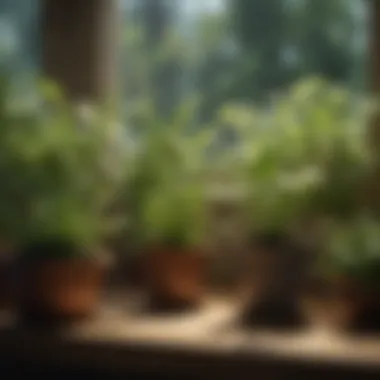
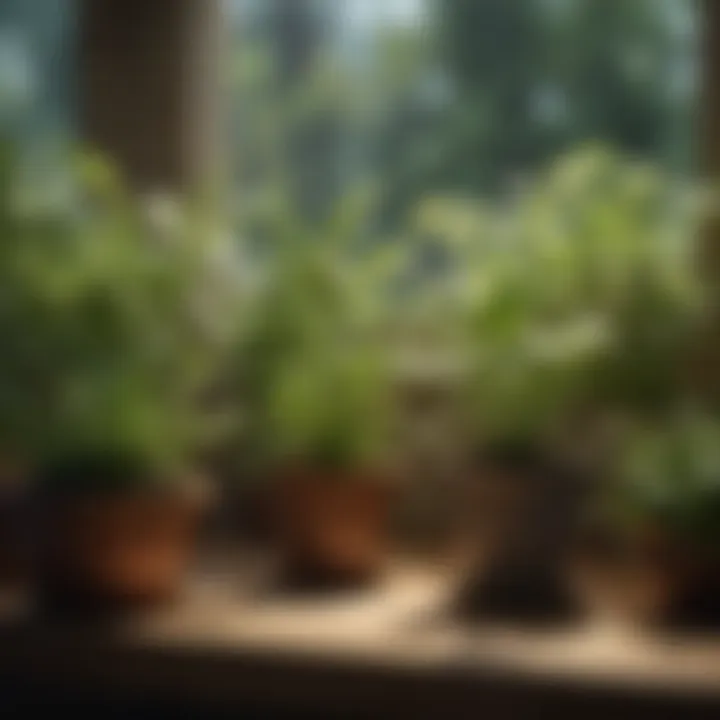
It's like a delicate dance; too much shine and they'll burn, too little and they'll twist and reach in vain. Here are some common symptoms to look out for:
- Yellowing Leaves: Particularly at the tips or between the veins.
- Curling Edges: Leaves that curl upwards may signal heat stress.
- Dark Spots or Patches: Unsightly marks which can indicate sunscald or uneven light exposure.
For effective herb cultivation, pay close attention to the light environment. Observing leaf patterns can ultimately guide you in adjusting your lighting solutions.
Stunted Growth Patterns
Another telltale sign of light stress is stunted growth patterns. When herbs fail to reach their full stature, or if their growth appears sluggish, this could very well point to an improper lighting situation. Stunted growth often results from light that is too dim or sporadic. The plants are not able to perform photosynthesis efficiently, similar to a student trying to learn in a dimly lit classroom. They struggle to absorb nutrients and grow effectively.
Additionally, environmental factors such as temperature and humidity can play a role, yet light is frequently the root cause. Keep for instance in mind:
- Compact and Short Plants: Indicative of insufficient light, these plants may remain small in stature and fail to produce lush foliage.
- Long Internodes: If the distance between leaves becomes elongated, it’s a clear signal that the plant is stretching toward the light, showing it needs a boost to grow.
Adapting light conditions promptly can help rectify these issues. Adjust the intensity, distance, or spectrum of light as necessary to encourage healthier growth. By closely monitoring your herbs, you ensure their vitality and, ultimately, a more bountiful yield in the long run.
"Healthy plants are like your best friends; they’ll let you know when something’s off."
Effective herb cultivation can be a journey filled with ups and downs. Recognizing light stress signs early can assist you in making timely interventions. This will encourage plants to flourish rather than flounder.
Adjusting Light for Seasonal Changes
In herb cultivation, adjusting light for seasonal changes is paramount for sustaining optimal growth and yields. As seasons shift, the natural availability of light alters, which affects indoor and outdoor gardening practices. Understanding how to modify your lighting setup according to these changes can significantly bolster the health of your plants and maximize their potential.
Seasonal adjustments ensure that the plants receive the right intensity and spectrum of light, which are critical for processes such as photosynthesis and flowering. This not only helps in maintaining a stable growth environment but also in avoiding light stress and its associated issues. Seasons can play tricks on even the most seasoned horticulturists, so keeping a finger on the pulse of light availability across the calendar year is essential.
Adapting To Shorter Day Lengths
As autumn rolls in and daylight diminishes, the challenge of shorter days comes to the forefront. Plants naturally respond to changes in light; for many herbs, growing times will slow down as the days shorten. This can be a worry for growers looking to maintain productivity.
To counterbalance reduced sunlight during these dwindling days, consider adjusting your artificial lighting system.
- Increase Light Duration: Extending the hours your lights are on can mimic the longer days of summer. This adjustment encourages herbs to grow, preventing premature dormancy.
- Transition to More Suitable Light Sources: If you’ve been using lower-intensity lights, consider switching to high-output LEDs that can deliver the necessary light quality even during shorter days.
- Monitor Plant Responses: Keep an eye on how your herbs react. If you notice a lack of growth or changes in leaf color, it might be time to rethink your lighting setup.
Compensating for Seasonal Light Variations
When the seasons change, so does the angle and intensity of light. In winter, for instance, sunlight can be scarce, leading to weak growth in herbs. This is where compensating for seasonal light variations becomes crucial.
Here are some strategies to consider:
- Utilize Full Spectrum Lighting: Full spectrum lights can mimic the natural sunlight better than many other options. This means your plants receive nearly the same range of light they would outdoors.
- Adjust Light Position: As the sun's angle changes throughout the year, so too should the position of your indoor lights. Hanging your lights at lower angles during winter can help maximize exposure.
- Implement Reflectors: Using reflectors can redistribute light in your growing space effectively. By bouncing light around, even a little increase can make a big difference in plant health.
"It's not just about the amount of light; it’s about the quality and timing of that light. Proper adjustments make all the difference in the health of herbs."
Analysis of Alternative Lighting Techniques
When it comes to herb cultivation, exploring alternative lighting techniques becomes crucial, especially in the realms of vertical farming and hydroponic systems. These innovative methods offer distinct advantages, which directly impact the health and yield of herbs grown indoors. Understanding these techniques allows gardeners to maximize their space and efficiency while ensuring that their plants receive the optimal light they need to thrive.
Vertical Farming Lighting Solutions
Vertical farming stands out as a game-changer in modern agriculture, allowing urban gardeners to grow herbs in stacked layers, using minimal space. The choice of lighting here is vital. LED lighting often takes center stage due to its energy efficiency and adaptability to various growth stages. These lights emit less heat, protecting plants from heat stress while providing the essential spectrum required for photosynthesis.
In vertical farming setups, positioning the lights can be tricky, but easy-to-implement solutions exist. Placing lights above each layer ensures that every plant receives equal light exposure. Additionally, using adjustable fixtures can help tailor the height as plants grow, ensuring consistent lighting throughout the cultivation process.
"In vertical farming, the right light not only boosts growth but also optimizes available space. It's like turning the usual gardening approach on its head."
Moreover, color temperature plays a role in plant growth; cooler light (around 6000k) generally promotes vegetative growth, while warmer light (about 2800k) encourages flowering. This understanding of light spectrum can help in achieving a wholesome growth process for herbs. As vertical farming gardens scale up, adopting smart light control systems can also keep budgets in check and ensure sustainability.
Hydroponic Systems and Light Use
Hydroponic systems, where plants grow in nutrient-rich water instead of soil, also benefit significantly from a well-thought-out lighting plan. Utilizing specific light setups can enhance the growth of various herbs, promoting lush greenery. In this setup, both LED and fluorescent lights are common choices due to their efficiency and effectiveness in providing the right spectrum.
Understanding the positioning and type of light is key here. For example, LEDs can be strategically placed closer to the plants without causing heat stress, vibrating at a frequency that promotes quicker growth. Additionally, combining red and blue light spectrums can be particularly effective, as red light supports flowering and blue light aids in vegetative development.
- Benefits of using light in hydroponic systems include:
- Controlled Environment: Less dependency on seasonal changes
- Year-Round Growth: Herbs can be cultivated continuously
- Increased Yield: With optimal lighting, yields can significantly improve
While delving into hydroponics, it's also essential to monitor the light's intensity, as too much can lead to light stress—stunting growth or causing leaf burn. Regular assessments with light meters can help ensure that your herbs receive just what they need.
In summary, exploring vertical farming and hydroponic systems, with their unique lighting needs and solutions, presents a path towards efficient and successful herb cultivation. Employing these alternative techniques effectively not only enhances plant health but helps in obtaining larger, more flavorful yields.
The End
Understanding the significance of light in herb cultivation can't be overstated. It's the sunflower that turns towards the sun; it directs the growth, flavor, and overall health of the precious plants we nurture. With so many options available—from incandescent lights that have been around since the dawn of electrical wonders to cutting-edge LED technologies—knowing where to shine that light makes all the difference for both the novice and the seasoned gardener.
Recap of Key Lighting Principles
To encapsulate the essence of proper lighting, let's revisit the core principles outlined in this article:
- Light Spectrum: Ensure you match the light spectrum of your chosen lighting. Red and blue wavelengths are crucial for photosynthesis. Full spectrum lighting, often touted as providing all light needed, can greatly enhance growth during all growth stages.
- Intensity Matters: Not every herb requires the same intensity of light. Some are sun-worshippers, while others do just fine in a shaded spot. An understanding of lux and PAR can help gauge appropriate light levels for your specific herbs.
- Seasonal Adjustments: The seasons will shift the natural availability of sunlight. Adapting your artificial lighting to seasonal changes is important to avoid stressed plants.
- Light Placement: The distance, angle, and orientation of your lighting can spell the difference between lush, aromatic herbs and leggy, sad plants.
- Continuous Assessment: Keeping an eye on your plants for signs of light stress—like discoloration, burn, and stunted growth—will help you tweak your lighting setup when necessary.
By getting down to these key points—a focused approach to selecting and placing your lights along with ongoing assessments—you can potentially double or even triple your herb yield, transforming your humble gardening venture into a flourishing success.
Final Thoughts on Herb Cultivation
When it comes down to brass tacks, herb cultivation isn't merely about planting seeds and hoping for the best. It's akin to an art form that requires patience, observation, and a pinch of science. Lighting, being a fundamental pillar, reflects this reality. Without the right lighting solutions, even the most carefully grown plants can end up as mere shadows of their potential.
In the grand scheme of gardening, every little detail contributes to the flavor and aroma of the herbs we intend to enjoy. Choosing the right type of lighting—and understanding its interaction with your plants—can unveil new depths of flavor and vitality in your herbs that you may never have previously thought possible. With the right knowledge in hand, anyone can cultivate a cornucopia of herbs to showcase to family and friends. As the traditions of herb gardening continue to be passed down, turning your passion into practice is more attainable than ever.
As you embark on this green-thumb journey, remember that a well-illuminated herb garden is not just a space of growth—it's a retreat for the senses, where every leaf dances under the glow of purposefully placed light, and every herb bursts with potential.







